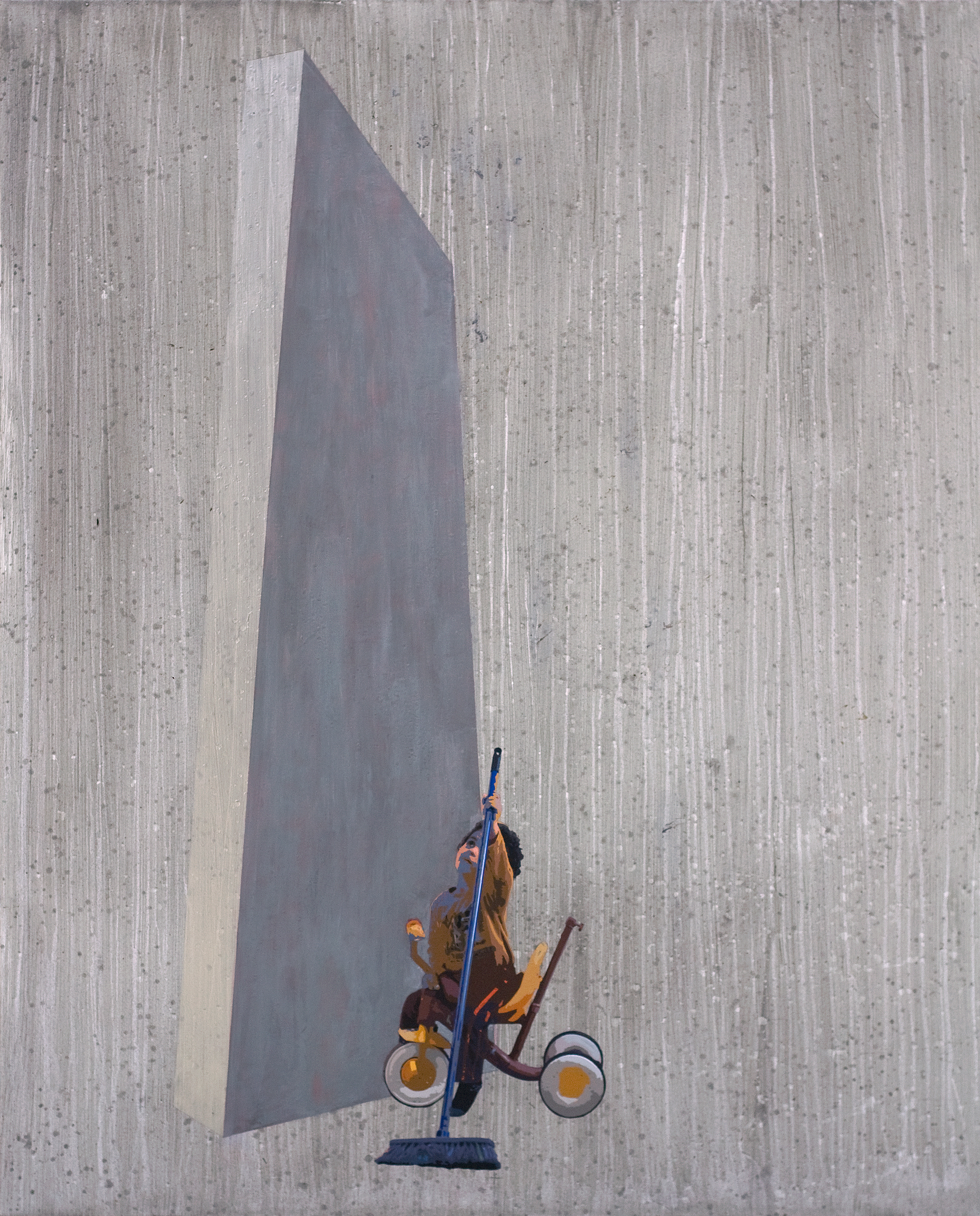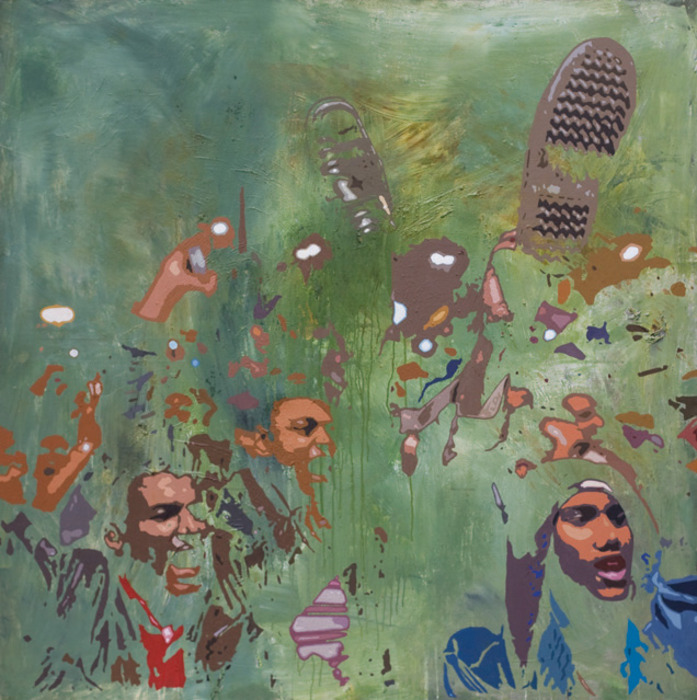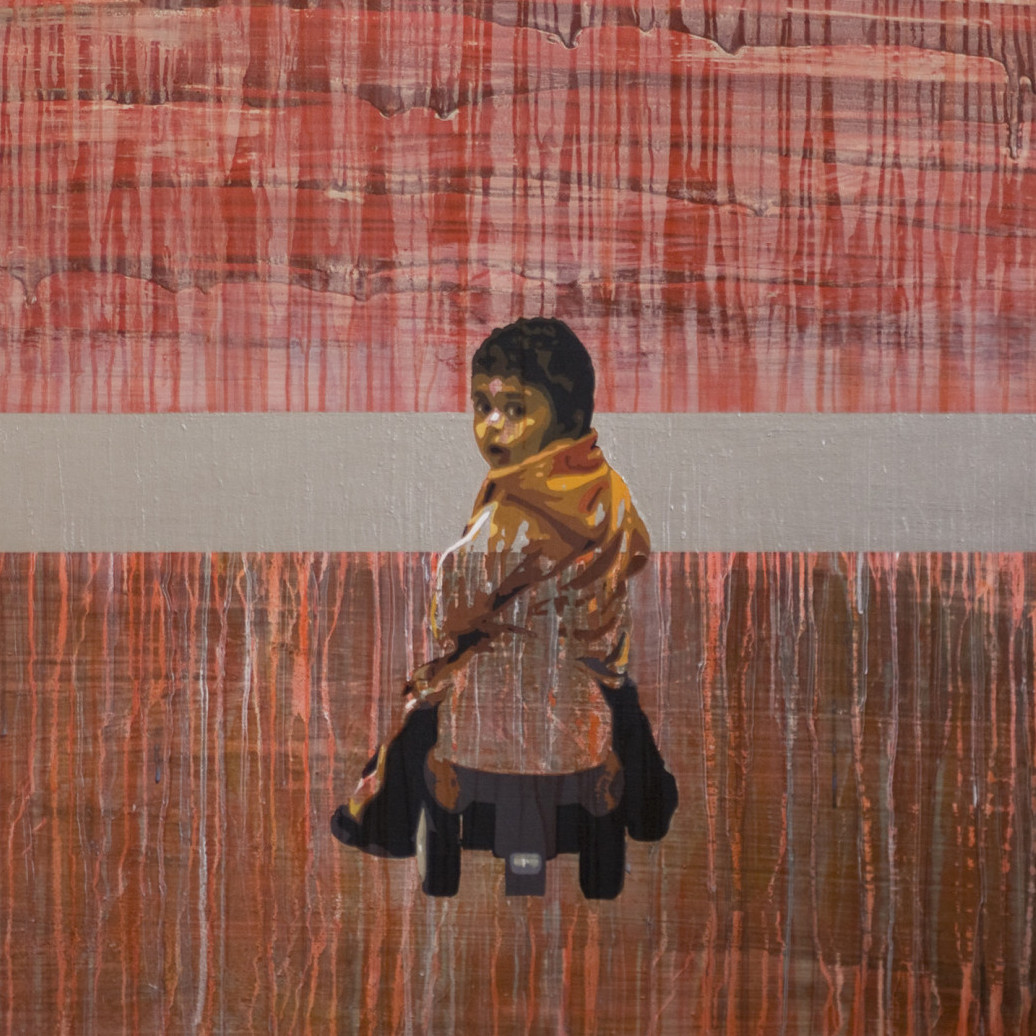Painting messages - the recent works of Palestinian artist Hani Zurob
The issue of regionalisation, which has long coloured many debates surrounding contemporary Middle Eastern art, and that is particularly entrenched in discussions about Palestinian artists is unavoidable when looking at Hani Zurob’s paintings. Zurob’s experiences as a Palestinian man - living with the weight of what that entails at different times and places – has led him to produce art, which, in his own words, disintegrates the boundaries between ‘political matters and private stories’. However, the artist’s exploration of suspended states of being – waiting, remembering, existing in cultural, historical, and socio-political grey areas – has resulted in works that translate personal and national experiences into a universal language.
One of Palestine’s most recognised and respected contemporary artists, Zurob’s works have been widely exhibited both at home and abroad. Recently, they were exhibited at the Al Markhiya Gallery in Doha, and are currently being shown at the Studio 3 Gallery at the University of Kent in England. On display in Qatar was Zurob’s Flying Lessons / Waiting series, which contains some of the artist’s most unique pieces. Inspired by a simple question – Daddy, why don’t you come with us to Jerusalem? – the series looks at the inability of Zurob’s son, Qoudsi, to grasp the politics behind his father’s absence from their home in Jerusalem, and the innocent rationality employed in his quest to remedy the absence. The message is one of hope, and an unending search for answers; maybe it is Quodsi, and those of his generation who will finally remedy the conflict that has dominated the lives of their parents and grandparents. As the preeminent Palestinian scholar Kamal Boutalla points out in his rigorously researched and sensitively written account of the artist’s life and work, Zurob is not the only Palestinian artist to translate to the inspiration of his offspring into art; however, unlike the photographic works of Steve Sabella, which primarily deal with feelings of displacement and estrangement caused by an absence from one’s homeland, Zurob’s works explore the way in which exile renders certain modes of travel irrelevant and eliminates the possibility of certain shared spaces. For those familiar with Zurob’s story, his exile in France is important to consider when ‘reading’ the works he produced there. While his son and wife are free to travel to France and see him, he is never able to visit them in Jerusalem.

Flying Lesson #6
The Flying Lessons / Waiting series, on the other hand, features brightly painted backgrounds with photographic images of Qoudsi in the foreground. Quodsi is sometimes seen on his tricycle, or in an aeroplane attempting to navigate through the composition. At others, he sits in an abstract space seemingly waiting for something to happen. The latent intensity in Quodsi’s movements and the references to aviation are both recurring themes in Zurob’s work. The idea of flying is particularly interesting in its employment here, when one considers the cultural symbolism inherent in the idea of flying away, and the way in which this symbolism ties Zurob’s works with the great Arabic literary tradition. Vivid colours, photorealistic portraits of Quodsi, and partially impenetrable spaces are the hallmarks of these works. Through them, Zurob attempts to compartmentalise the conceptual spaces inhabited by Quodsi, the exiled artist / father, and Palestine, a space that unites them despite the fact that they are physically unable to share it.
While the aesthetic ambiguity of the spaces depicted in this series is a familiar attribute of the artist’s practice, the severe linearity, photorealistic depictions, and measured application of paint all hint at a change in direction. It is these works that Zurob identifies as his favourites; according to him, they represent a stylistic progression, and a sense of ‘finding’ his style. It is true that much of the artist’s earlier works – such as the Siege, Palm Tree, Door, and Sortie series – painted shortly after his arrival in Paris all display some of the qualities (e.g. the colours in Sortie and the figural emphasis in Siege) present in his more recent works; however, one senses that the frenetic energy, the need to daub paint across a canvas using whatever instruments are at hand – be they fingers, spatulas, or plastic cards – and the textures created through Zurob’s inclusion of mixed media and found objects have been replaced by a more refined and clarified approach.
Zurob’s works explore the way in which exile renders certain modes of travel irrelevant and eliminates the possibility of certain shared spaces
In contrast to this series is Zurob’s sole contribution to the Resilience and Light exhibition of Palestinian art, currently showing at the University of Kent: a painting entitled The Arab Spring is Not Yet Complete. The artist began working on the piece when the Arab Spring first began in Tunisia in 2010, and completed it while watching the events unfold there and later in nearby Egypt. The painting swells like a turquoise sea, with the fragmented pieces – of partially-obscured faces, mouths chanting slogans of change, upturned palms - of those at the heart of the uprising beautifully mirroring the chaotic energy often associated with the Arab Spring in the West. As Zurob mentions, it has deliberately been left unfinished; the Arab Spring has yet to fulfil the aims of those ‘driving’ it, and as such, his painting indicates a sense of transience and the potential for change.

The Arab Spring is Not Yet Complete
Aside from serving as a telling piece of art, The Arab Spring is Not Yet Complete also showcases Zurob’s strength as a figurative painter – something that becomes particularly interesting when regarding Zurob’s work alongside those of his contemporaries. Of all the artists participating in the exhibition – including Taysir Batniji, Hazem Harb, Mohammed Joha, and Laila Shawa – Zurob is the only one exhibiting a painting. In talking with Zurob, it becomes clear that the message, rather than the medium is key for him. As he mentions, he is open to the possibility of working with more ‘conceptual’ mediums, as long as they can effectively communicate his message. That being said, however, it is obvious that paint is his preferred medium of choice. ‘Painting is where I am strong. Painting is my challenge’, he says.
Hani Zurob’s paintings are an exercise in understanding, each appearing as an effort to comprehend and - in some cases – normalise the transience of things that remain essential in shaping the artist’s life. ‘The role of the artist shifted from one of [a] genius – mastering techniques – to one of an investigator, creating art that finds contentment and complexity in thought’, Sabella states in an essay on the subject of conceptual Palestinian art. These words bring Zurob’s paintings to mind. What makes his work so appealing, perhaps, is his ability to present the complexities of contemporary thought and feeling through a traditional medium that has been dismissed by so many for its inability to do exactly that.
‘Resilience and Light’ runs through May 18, 2013 at Studio 3 Gallery.

